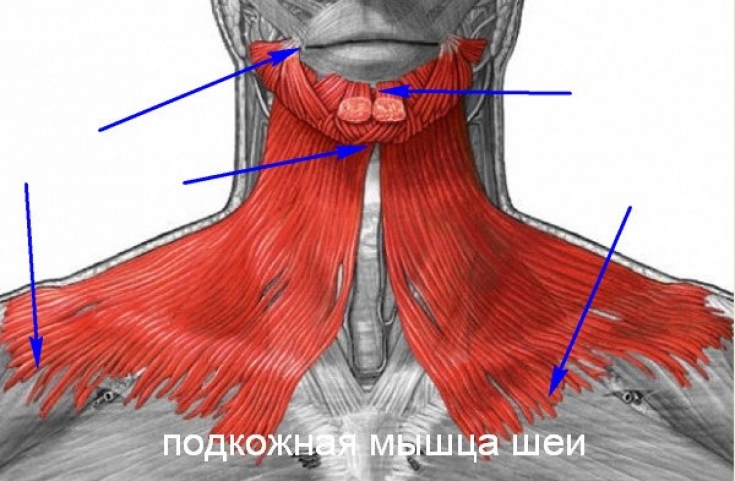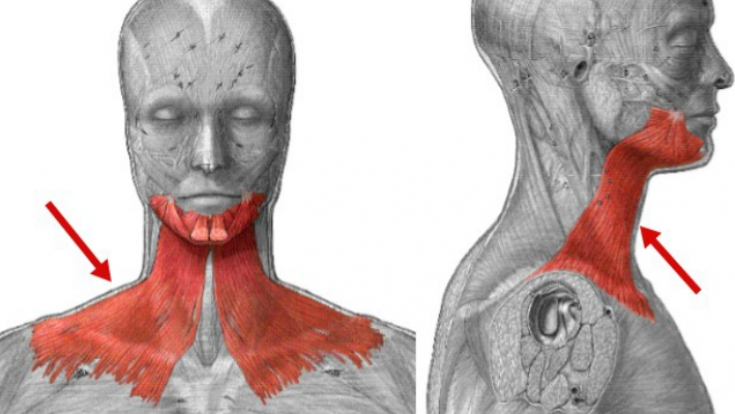The subcutaneous muscle of the neck is located directly under the skin between the chest and chin. It is not involved in the normal movements of the neck and head, but facilitates blood circulation under the neck, pulling back the skin in this area.
Due to anatomical features (lack of connection with the bone structure, thin adipose tissue and a small number of sebaceous glands), this muscle is prone to loss of elasticity and dryness, which leads to the formation of wrinkles. As a result, platysma plays a huge role in the appearance of signs of aging on the neck.
Age-related changes in the subcutaneous muscle and skin of the neck
Due to the thinness of the skin and subcutaneous fat, the absence of an extensive vascular network and the low activity of the anterior cervical muscles, the following age-related changes appear:
- dry skin;
- loss of tissue tone;
- tissue atrophy;
- skin ptosis;
- wrinkles and strands;
- ring pleats.
The subcutaneous muscle of the neck is also "guilty" of in the appearance of deep transverse folds, wrinkling of the neck, loss of tone and sagging of the skin of the chin, the formation of longitudinal strands and an increase in the neck-chin angle, which is 90o in young people.

In addition, the chin-cervical region is classified as a fat trap, because due to its characteristics, when gaining weight, fat accumulates in it very quickly, but it is reluctant to leave when losing weight. A double chin, however, is not necessarily due to being overweight.
A number of age-related changes in the neck are associated with platysma.
When fatty tissue accumulates in the chin area, the subcutaneous muscle of the neck partially thickens in the middle to compensate for such changes. This leads to the appearance of so-called strands.
Below estet-portal.com will review:
- how to avoid age-related changes caused by the subcutaneous muscle of the neck;
- exercises for platysma.
How to deal with age-related changes caused by the subcutaneous muscle of the neck?
To correct the condition of the neck without resorting to invasive techniques, it is necessary to pay attention to three main aspects:
- posture;
- facial expressions;
- hormones.
As for the first point, the habit of stooping (and later on, posture disorder) – one of the main enemies of a young neck, because as a result, blood circulation in the neck deteriorates, and fat in the chin area accumulates faster. Platysma is already atrophying quickly, why speed up this process by constantly stooping?
Pay attention to your facial expressions: if you very often express negativity and disgust on your face, i.e. lower the corners of the mouth, this negatively affects the condition of the subcutaneous muscle of the neck. Try to relax the muscle that lowers the corners of your mouth. And the effect of correction of the subcutaneous muscle of the neck is achieved by relaxing the depressor muscles and activating the levator muscles of the middle third of the face.
Massaging platysma is not worth it as it will stretch the skin and will only hasten or aggravate the signs of neck aging.
Another important point in keeping the platysma in good condition is to avoid overexerting it during exercise. Look at yourself in the mirror and if you notice that the muscles in your neck are overly tense, take a break and relax. Try to avoid excessive loads whenever possible.
Hormonal imbalance also negatively affects the condition of the neck, namely:
- in case of hypothyroidism;
- with menopause;
- in case of goiter.

Exercises to help tone the subcutaneous muscle of the neck
Performing the right exercises, you can increase the tone of platysma. Here are some of them:
- Squeeze the subcutaneous muscle of the neck as much as possible while inhaling, hold the tension for 6 seconds, and completely relax the muscle as you exhale. To reduce platysma, it is necessary to forcefully lower the chin and lower lip (simultaneously). The face will not look very attractive, so try to focus your attention on the muscle you are working with: it goes from the chest to the chin, the corners of the mouth and the lower lip. It is important that no new folds appear on the cheeks, around the mouth and under the lower lip during platysma tension. Repeat the exercise 4-5 times.
- Playing wind instruments – great calf workout that helps prevent neck flabbiness.
- Simple exercises that keep platysma tone are:
- head tilts forward;
- head tilts back;
- head tilts to the sides;
- head rotation.
Read also: 8 simple neck lift exercises
- Tilt your head forward, fix the skin of your chest with your palms at the level of II-III ribs. While inhaling, slowly raise your head and move it back.
- The lion pose is performed as follows: sit on your knees and put your palms on them, spread your fingers; stretch your neck and press your chin to your chest; eyes look askance; inhale and as you exhale, stretch your tongue forward and down as much as possible, tensing your neck and stretching it up.
Estet-portal.com also reminds that there are many aesthetic procedures aimed at rejuvenating the neck in case exercises are not enough to correct the condition of this area: surgical and non-invasive.








Add a comment